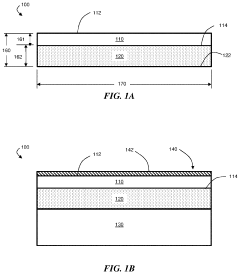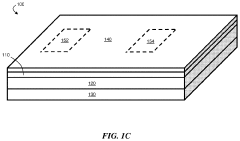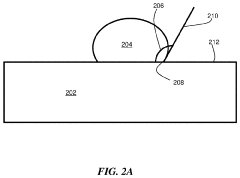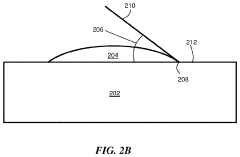Antifreeze Deployment for Transformative Industrial Systems Modeling
Antifreeze Tech Evolution
The evolution of antifreeze technology for transformative industrial systems modeling has undergone significant advancements over the past decades. Initially, antifreeze solutions were primarily used in automotive and industrial cooling systems to prevent freezing and corrosion. However, as industrial systems became more complex and sophisticated, the need for advanced antifreeze technologies in modeling and simulation environments emerged.
In the early stages, antifreeze deployment in industrial systems modeling focused on basic temperature control and prevention of system failures due to freezing. These early solutions were often simplistic and lacked the ability to adapt to dynamic environmental conditions. As computational power increased, more sophisticated modeling techniques were developed, allowing for better prediction and prevention of freeze-related issues in industrial systems.
The mid-2000s saw a shift towards the integration of smart sensors and real-time monitoring capabilities in antifreeze systems. This advancement enabled more accurate detection of potential freezing conditions and allowed for proactive measures to be taken. Concurrently, the development of advanced materials and nanomaterials led to the creation of more efficient and environmentally friendly antifreeze solutions, which could be incorporated into industrial system models.
The rise of artificial intelligence and machine learning in the 2010s marked a significant turning point in antifreeze technology for industrial systems modeling. These technologies enabled the development of predictive models that could anticipate freezing conditions based on a wide range of environmental and operational factors. This predictive capability allowed for more efficient and effective deployment of antifreeze measures in complex industrial systems.
Recent years have seen a focus on sustainability and energy efficiency in antifreeze technology. Researchers have been working on developing bio-based antifreeze solutions and exploring ways to recover and recycle antifreeze materials. These advancements have been incorporated into industrial systems modeling, allowing for more environmentally conscious and cost-effective antifreeze deployment strategies.
The current state of antifreeze technology in transformative industrial systems modeling involves a holistic approach that combines advanced materials, smart sensors, AI-driven predictive models, and sustainable practices. This integrated approach allows for more accurate simulation of freeze-related phenomena in complex industrial environments, leading to improved system reliability and performance.
Looking ahead, the evolution of antifreeze technology is expected to continue with a focus on further integration with Internet of Things (IoT) platforms, enhanced AI capabilities for real-time decision-making, and the development of self-healing antifreeze materials. These advancements will likely lead to even more sophisticated and efficient antifreeze deployment strategies in industrial systems modeling, ultimately contributing to more resilient and adaptable industrial processes.
Industrial Demand Analysis
The demand for antifreeze deployment in transformative industrial systems modeling is driven by the increasing complexity and scale of modern industrial processes. As industries undergo digital transformation, there is a growing need for robust modeling systems that can operate reliably in diverse environmental conditions, including extreme cold temperatures.
The market for antifreeze solutions in industrial modeling is closely tied to sectors such as oil and gas, chemical processing, and power generation, where operations in cold climates are common. These industries require sophisticated modeling tools that can accurately simulate and predict system behavior under freezing conditions. The ability to maintain operational efficiency and prevent equipment failures in harsh environments is a critical factor driving the demand for antifreeze-enabled modeling systems.
Furthermore, the rise of Industry 4.0 and the Internet of Things (IoT) has led to an increased integration of sensors and smart devices in industrial settings. These devices often need to function in outdoor environments or unheated facilities, creating a demand for modeling systems that can account for the effects of freezing temperatures on sensor performance and data accuracy.
The automotive and aerospace industries also contribute significantly to the demand for antifreeze deployment in modeling systems. As these sectors expand their operations into colder regions and develop vehicles capable of functioning in extreme conditions, there is a growing need for simulation tools that can accurately model the behavior of materials and systems under freezing temperatures.
Climate change and the expansion of industrial activities into previously uninhabited regions have further intensified the demand for antifreeze-enabled modeling systems. As companies explore opportunities in Arctic and sub-Arctic areas, they require advanced modeling capabilities to ensure the safety and efficiency of their operations in these challenging environments.
The market for antifreeze deployment in industrial systems modeling is also influenced by regulatory requirements and safety standards. Industries operating in cold climates must comply with stringent regulations regarding equipment performance and environmental protection. This drives the need for modeling systems that can accurately predict and mitigate the risks associated with freezing conditions.
As sustainability becomes an increasingly important consideration in industrial operations, there is a growing demand for modeling systems that can optimize energy consumption and reduce the environmental impact of antifreeze measures. This includes the development of more efficient heat transfer models and the integration of renewable energy sources into cold climate operations.
Current Challenges
The deployment of antifreeze systems in transformative industrial modeling faces several significant challenges. One of the primary obstacles is the complexity of integrating antifreeze mechanisms into existing industrial systems without disrupting ongoing operations. Many industrial processes are highly sensitive to changes, and introducing new elements like antifreeze systems can potentially alter critical parameters, affecting product quality and process efficiency.
Another major challenge lies in the diverse range of industrial environments that require antifreeze solutions. Different industries, from chemical processing to food production, have unique requirements and constraints. Developing a one-size-fits-all antifreeze deployment strategy is impractical, necessitating customized approaches for various sectors. This diversity complicates the research and development process, requiring extensive testing and validation across multiple industrial scenarios.
The cost-effectiveness of antifreeze deployment also presents a significant hurdle. While the benefits of preventing system freezing are clear, the initial investment and ongoing maintenance costs can be substantial. Many industries, particularly those operating in regions with mild climates, may struggle to justify the expense, especially when weighing it against other operational priorities. This economic factor often leads to reluctance in adopting comprehensive antifreeze solutions, potentially leaving systems vulnerable during unexpected cold snaps.
Technical limitations in current antifreeze technologies pose another challenge. Many existing solutions are not fully compatible with the advanced modeling systems used in transformative industrial processes. Issues such as chemical compatibility, thermal efficiency, and long-term stability of antifreeze compounds in complex industrial environments need to be addressed. Additionally, the potential environmental impact of antifreeze chemicals is a growing concern, necessitating the development of more eco-friendly alternatives that maintain effectiveness without compromising sustainability goals.
The integration of antifreeze systems with emerging technologies like IoT (Internet of Things) and AI-driven predictive maintenance presents both opportunities and challenges. While these technologies offer the potential for more efficient and responsive antifreeze deployment, they also introduce new complexities in terms of data management, system security, and the need for specialized expertise in both antifreeze technology and advanced digital systems.
Lastly, regulatory compliance and safety standards pose significant challenges in antifreeze deployment research. As industrial processes become more complex and interconnected, ensuring that antifreeze systems meet all relevant safety and environmental regulations across different jurisdictions becomes increasingly difficult. This regulatory landscape is often in flux, requiring continuous adaptation and innovation in antifreeze deployment strategies to maintain compliance while maximizing effectiveness.
Existing Antifreeze Solutions
01 Antifreeze deployment systems for aircraft
Antifreeze deployment systems designed specifically for aircraft to prevent ice formation on critical surfaces. These systems typically involve spraying or distributing antifreeze solutions onto wings, control surfaces, and other vulnerable areas to maintain safe flight operations in icy conditions.- Antifreeze deployment systems for aircraft: Systems designed to deploy antifreeze solutions on aircraft surfaces to prevent ice formation. These systems typically include storage tanks, pumps, and distribution networks to apply the antifreeze efficiently across critical areas such as wings and control surfaces.
- Antifreeze compositions for automotive applications: Specialized antifreeze formulations developed for use in automotive cooling systems. These compositions often include additives to enhance heat transfer, prevent corrosion, and maintain optimal engine performance in extreme temperature conditions.
- Environmentally friendly antifreeze solutions: Development of eco-friendly antifreeze alternatives that reduce environmental impact. These solutions may incorporate biodegradable components or utilize renewable resources to achieve antifreeze properties while minimizing ecological harm.
- Antifreeze deployment mechanisms for industrial equipment: Specialized systems for deploying antifreeze in industrial settings, such as power plants, refineries, or large-scale manufacturing facilities. These mechanisms are designed to protect critical equipment and piping from freezing in cold environments.
- Smart antifreeze deployment technologies: Advanced systems incorporating sensors, automated controls, and predictive algorithms to optimize antifreeze deployment. These technologies can adjust deployment based on real-time weather conditions, surface temperatures, and other relevant factors to improve efficiency and effectiveness.
02 Antifreeze composition formulations
Development of specialized antifreeze compositions tailored for various applications. These formulations may include a combination of glycols, corrosion inhibitors, and other additives to enhance performance in different environmental conditions and for specific equipment types.Expand Specific Solutions03 Automated antifreeze deployment systems
Automated systems for detecting icing conditions and deploying antifreeze solutions as needed. These systems may incorporate sensors, control units, and distribution mechanisms to ensure timely and efficient application of antifreeze in various industrial and transportation settings.Expand Specific Solutions04 Antifreeze recycling and environmental considerations
Methods and systems for recycling and managing antifreeze solutions to minimize environmental impact. This includes techniques for collecting, purifying, and reusing antifreeze, as well as developing more environmentally friendly formulations.Expand Specific Solutions05 Antifreeze deployment in energy storage systems
Specialized antifreeze deployment techniques for energy storage systems, particularly in batteries and fuel cells. These methods aim to maintain optimal operating temperatures and prevent freezing in extreme conditions, ensuring consistent performance and longevity of energy storage devices.Expand Specific Solutions
Key Industry Players
The research on antifreeze deployment for transformative industrial systems modeling is in its early stages, with the market still developing. The global industrial systems modeling market is expected to grow significantly in the coming years, driven by increasing demand for efficient and sustainable industrial processes. Key players in this emerging field include Massachusetts Institute of Technology, State Grid Corp. of China, and Gree Electric Appliances, Inc. of Zhuhai. These organizations are at the forefront of developing advanced modeling techniques and antifreeze technologies for industrial applications. The technology is still evolving, with ongoing research focused on improving efficiency, reliability, and environmental sustainability in industrial systems across various sectors.
Massachusetts Institute of Technology
State Grid Corp. of China
Core Antifreeze Innovations
- A metered antifreeze application device, with a storage container and shut-off element, is attached to the system, applying liquid or pasty antifreeze to exposed surfaces using a drip or spray nozzle, controlled by a frost monitor and electronic control unit to ensure reliable protection against icing, suitable for various types of scrapers and chain systems.
- A photothermal trap system that converts electromagnetic radiation into heat using a cermet absorber and thermal spreader, efficiently transferring heat laterally to inhibit or induce phase changes on surfaces, even in shaded areas, through a combination of high absorptivity and low emissivity materials.
Environmental Impact
The deployment of antifreeze systems in transformative industrial modeling has significant environmental implications that must be carefully considered. These systems, while crucial for maintaining operational efficiency in cold climates, can potentially impact the surrounding ecosystem and contribute to environmental degradation if not properly managed.
One of the primary environmental concerns is the potential for antifreeze chemicals to leak or spill into soil and water systems. Many antifreeze solutions contain ethylene glycol or propylene glycol, which can be toxic to plants, animals, and microorganisms if released into the environment. Even small, chronic leaks can accumulate over time, leading to long-term contamination of groundwater and soil.
Air quality is another important consideration. Some antifreeze formulations may release volatile organic compounds (VOCs) during their use or disposal, contributing to air pollution and potentially affecting local air quality. This is particularly relevant in enclosed industrial spaces where proper ventilation is crucial to maintain a safe working environment.
The production and disposal of antifreeze solutions also have environmental ramifications. Manufacturing processes for antifreeze chemicals often involve energy-intensive operations and the use of non-renewable resources. Improper disposal of used antifreeze can lead to contamination of landfills and water treatment facilities, placing additional strain on waste management systems.
However, advancements in antifreeze technology are addressing some of these environmental concerns. The development of bio-based and biodegradable antifreeze solutions offers more environmentally friendly alternatives to traditional petroleum-based products. These newer formulations can reduce the environmental impact of both production and disposal processes.
Recycling and proper handling of antifreeze solutions are becoming increasingly important in industrial settings. Implementing closed-loop systems and effective recycling programs can significantly reduce the volume of antifreeze waste generated and minimize the risk of environmental contamination. Additionally, the use of advanced leak detection systems and regular maintenance protocols can help prevent unintended releases of antifreeze into the environment.
As industrial systems modeling continues to evolve, there is a growing emphasis on incorporating environmental considerations into the design and deployment of antifreeze systems. This includes developing more efficient heat exchange systems that require less antifreeze, as well as exploring alternative cooling methods that may reduce or eliminate the need for traditional antifreeze solutions in certain applications.
Regulatory Compliance
Regulatory compliance is a critical aspect of antifreeze deployment in transformative industrial systems modeling. As industries increasingly adopt advanced modeling techniques, they must navigate a complex landscape of regulations to ensure the safe and responsible use of antifreeze technologies. The primary regulatory bodies overseeing this domain include environmental protection agencies, occupational safety and health administrations, and industry-specific regulatory authorities.
Environmental regulations play a significant role in antifreeze deployment. Many jurisdictions have strict guidelines on the storage, handling, and disposal of antifreeze substances due to their potential environmental impact. Companies must adhere to these regulations to prevent soil and water contamination, as well as to protect local ecosystems. This often involves implementing proper containment systems, regular monitoring, and reporting procedures.
Occupational safety regulations are equally important in the context of antifreeze deployment. These regulations typically mandate the use of personal protective equipment, proper training for personnel handling antifreeze substances, and the implementation of safety protocols to prevent accidents and exposure. Companies must ensure that their modeling systems and deployment strategies align with these safety requirements to protect workers and maintain regulatory compliance.
Industry-specific regulations also come into play, particularly in sectors such as automotive, aerospace, and energy production. These regulations often dictate the specific types of antifreeze that can be used, performance standards, and testing requirements. Compliance with these industry-specific regulations is crucial for ensuring the reliability and safety of industrial systems in extreme temperature conditions.
As transformative industrial systems modeling continues to evolve, regulatory frameworks are also adapting to address new challenges and technologies. This includes regulations surrounding the use of artificial intelligence and machine learning in modeling processes, data privacy concerns, and the integration of Internet of Things (IoT) devices in antifreeze monitoring systems. Companies engaged in antifreeze deployment must stay abreast of these evolving regulations to maintain compliance and avoid potential legal and financial repercussions.
To ensure comprehensive regulatory compliance, companies often implement robust management systems that include regular audits, documentation processes, and continuous training programs. These systems help track changes in regulations, assess compliance status, and implement necessary adjustments to antifreeze deployment strategies. Additionally, many organizations choose to work closely with regulatory bodies and industry associations to stay informed about upcoming regulatory changes and contribute to the development of new standards.







